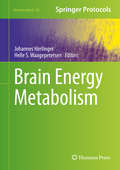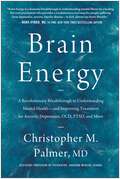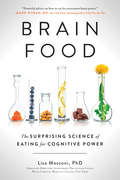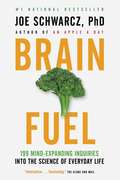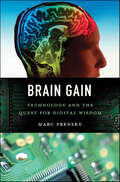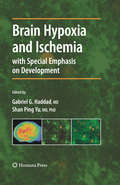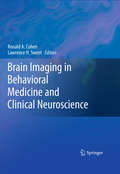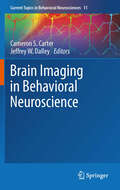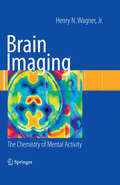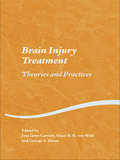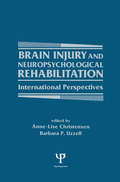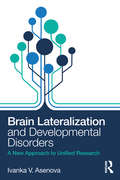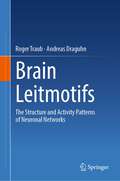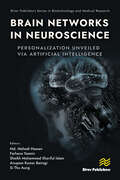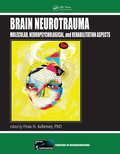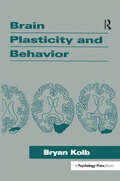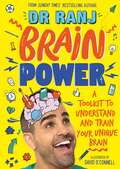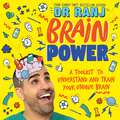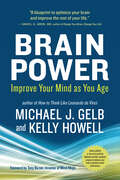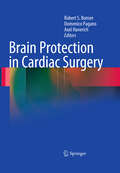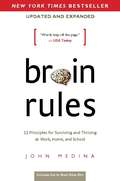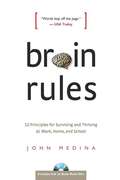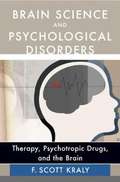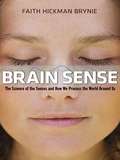- Table View
- List View
Brain Energy Metabolism: Focus On Energy And Neurotransmitter Amino Acid Homeostasis (Neuromethods #90)
by Johannes Hirrlinger Helle S. WaagepetersenBrain Energy Metabolism addresses its challenging subject by presenting diverse technologies allowing for the investigation of brain energy metabolism on different levels of complexity. Model systems are discussed, starting from the reductionist approach like primary cell cultures which allow assessing of the properties and functions of a single brain cell type with many different types of analysis, however, at the expense of neglecting the interaction between cell types in the brain. On the other end, analysis in animals and humans in vivo is discussed, maintaining the full complexity of the tissue and the organism but making high demands on the methods of analysis. Written for the popular Neuromethods series, chapters include the kind of detailed description and key implementation advice that aims to support reproducible results in the lab. Meticulous and authoritative, Brain Energy Metabolism provides an ideal guide for researchers interested in brain energy metabolism with the hope of stimulating more research in this exciting and very important field.
Brain Energy: A Revolutionary Breakthrough in Understanding Mental Health--and Improving Treatment for Anxiety, Depression, OCD, PTSD, and More
by Christopher M. Palmer&“[A] revolutionary road map for people suffering from depression, anxiety, bipolar disease . . . almost any brain disorder." —Mark Hyman, MD, New York Times bestselling author of Young Forever Discover the surprising link between your metabolism and mental health in this cutting-edge guide with practical advice for treatment and care. Drawing on decades of research, Harvard psychiatrist Dr. Chris Palmer outlines a revolutionary new understanding that for the first time unites our existing knowledge about mental illness within a single framework: Mental disorders are metabolic disorders of the brain. Brain Energy explains this new understanding of mental illness in detail, from symptoms and risk factors to what is happening in brain cells. Palmer also sheds light on the new treatment pathways this theory opens up—which apply to all mental disorders, including anxiety, depression, ADHD, alcoholism, eating disorders, bipolar disorder, autism, and even schizophrenia. This groundbreaking guide pairs cutting-edge science with practical advice and strategies to help people reclaim their mental health. Inside, Palmer reveals: Why classifying mental disorders as &“separate&” conditions is misleading The clear connections between mental illness and disorders linked to metabolism, including diabetes, heart attacks, strokes, pain disorders, obesity, Alzheimer&’s disease, and epilepsy The link between metabolism and every factor known to play a role in mental health, including genetics, inflammation, hormones, neurotransmitters, sleep, stress, and trauma The evidence that current mental health treatments, including both medications and therapies, likely work by affecting metabolism New treatments available today that readers can use to promote long-term healing Palmer puts together the pieces of the mental illness puzzle to provide answers and offer hope. Brain Energy will transform the field of mental health, and the lives of countless people around the world.
Brain Food: The Surprising Science Of Eating For Cognitive Power
by Lisa MosconiHow to eat for maximum brain power and health from an expert in both neuroscience and nutrition.Like our bodies, our brains have very specific food requirements. And in this eye-opening book from an author who is both a neuroscientist and a certified integrative nutritionist, we learn what should be on our menu. Dr. Lisa Mosconi, whose research spans an extraordinary range of specialties including brain science, the microbiome, and nutritional genomics, notes that the dietary needs of the brain are substantially different from those of the other organs, yet few of us have any idea what they might be. Her innovative approach to cognitive health incorporates concepts that most doctors have yet to learn. Busting through advice based on pseudoscience, Dr. Mosconi provides recommendations for a complete food plan, while calling out noteworthy surprises, including why that paleo diet you are following may not be ideal, why avoiding gluten may be a terrible mistake, and how simply getting enough water can dramatically improve alertness. Including comprehensive lists of what to eat and what to avoid, a detailed quiz that will tell you where you are on the brain health spectrum, and 24 mouth-watering brain-boosting recipes that grow out of Dr. Mosconi's own childhood in Italy, Brain Food gives us the ultimate plan for a healthy brain. Brain Food will appeal to anyone looking to improve memory, prevent cognitive decline, eliminate brain fog, lift depression, or just sharpen their edge.
Brain Fuel: 199 Mind-expanding Inquiries into the Science of Everyday Life
by Joe SchwarczNational Bestseller. From the #1 bestselling author - a cornucopia of mind-expanding insights into the science of the real world. Dr. Joe - as he is affectionately known to millions of readers, listeners, viewers, and students - brings his magic formula to Doubleday Canada with Brain Fuel. As with Dr. Joe's previous best-selling books, Brain Fuel informs and entertains on a wild assortment of science-based topics. But this is not "science trivia." If you are looking for serious scientific discussions, you'll find them here. If you are looking for practical consumer information, that's here too. If you are searching for ways to stimulate interest in science, look no further, Mom. And if you are simply wondering why the birth of Prince Leopold was so different from Queen Victoria's previous seven; or why an iron rod that went through a man's head is now on display in a museum in Boston; or why white chocolate has such a short shelf life; or why eggs terrified Alfred Hitchcock - and what all of this means for the rest of us, and why - then bingo.
Brain Gain: Technology and the Quest for Digital Wisdom
by Marc Prensky"In an age where the answer to every question is at your fingertips, where does the human brain fit in?"In one hand-held object, we are able to manage all of our calendars, documents, and interpersonal relationships with such ease that many people are lost when forced to do perform these tasks without the aid of electronics. Often heard are the calls for less technology and more face-to-face interaction, for fear that the use of all this artificial intelligence is dampening our own ability to think.Author Marc Prensky has a different idea. In this controversial and well-argued treatise, Prensky offers the idea that rather than stunting the mind—that most essential aspect of an individual's intelligence and sense of self—smart technology (and smart use of technology) enhances our humanity in ways that the brain on its own never could. Through scores of fascinating examples, Prensky shows that the symbiotic combination of the human brain and technology—from marrying the brain's strengths such as sense-making and complex reasoning abilities with technology's strengths like storing and processing large amounts of data—has great benefits for our own cognitive functioning. How should we best combine the strengths of mind and machine for maximum benefit? Prensky's call is for digital wisdom—a new interconnectedness between human and technology that is already enabling Homo Sapiens to begin the journey into the next stages of cognitive evolution.
Brain Hypoxia and Ischemia: With Special Emphasis On Development (Contemporary Clinical Neuroscience)
by Gabriel G. Haddad Shan Ping YuBrain Hypoxia and Ischemia explores the various aspects of cell death and survival that are crucial for understanding the basic mechanisms underlying brain hypoxia and ischemia. Chapters focus on a panorama of issues including the role of ion channels/transporters, mitochondria and apoptotic mechanisms, the roles of glutamate/NMDA, mechanisms in penumbral cells and the importance of intermittent hypoxia and gene regulation under these stressful conditions. The volume explores findings from both mammalian and invertebrate model systems and their applicability to human systems and diseases. Careful consideration is also given to differences in hypoxia and ischemia across development. This volume aims to increase the understanding of these mechanisms and to stimulate research on better diagnosis and treatment of diseases that afflict the brain and potentially other organs when O2 levels are dysregulated. Brain Hypoxia and Ischemia is designed for neuroscientists, clinicians and medical/graduate students for use in both basic research and clinical practice.
Brain Imaging in Behavioral Medicine and Clinical Neuroscience
by Ronald A. Cohen Lawrence H. SweetRapid developments in brain neuroimaging methods have occurred over the past decade. These advances have revolutionized cognitive and behavioral neuroscience, and are likely to have major influence on clinical psychological, psychiatric, and neurological practice over the coming years. There are a number of excellent books that focus on specific neuroimaging methods, such as fMRI. Furthermore, cognitive and neuroscience texts have increasingly incorporated functional brain neuroimaging. Yet, there are few books to date that consider and review emerging research in the application of brain neuroimaging methods for the study and assessment of behavioral and cognitive disorders. This book provides a broad coverage of current research trends in the clinical application of brain neuroimaging methods in the context of behavioral medicine, neuropsychology, and related areas of medical psychology. It uniquely integrates current neuroimaging methods and studies with current behavioral medicine research, and presents knowledge derived from recent developments in the fields of functional and structural brain imaging. By integrating information from experimental behavioral medicine with clinical insights, this book will serve as a source book for neuropsychologists, psychologists, neurologists, psychiatrists, and other professionals in both clinical practice and academic context. This integration results in the reader having a greater understanding of how the brain controls behavior, the disturbances of behavior that may occur with different disorders, and what clinicians should consider when assessing or working with patients with behavioral problems.
Brain Imaging in Behavioral Neuroscience (Current Topics in Behavioral Neurosciences #11)
by Cameron S. Carter Jeffrey W. DalleyThis volume highlights the remarkable new developments in brain imaging, including those that apply magnetic resonance imaging (MRI) and Positron Emission Tomography (PET), that allow us to non invasively study the living human brain in health and in disease. These technological advances have allowed us to obtain new and powerful insights into the structure and function of the healthy brain as it develops across the life cycle, as well as the molecular make up of brain systems and circuits as they develop and change with age. New brain imaging technologies have also given us new insights into the causes of many common brain disorders, including ADHD, schizophrenia, depression and Alzheimer's disease, which collectively affect a large segment of the population. These new insights have major implications for understanding and treating these brain disorders, and are providing clinicians with the first ever set of biomarkers that can be used to guide diagnosis and monitor treatment effects. The advances in brain imaging over the last 20 years, summarized in this volume, represent a major advance in modern biomedical sciences.
Brain Imaging: The Chemistry of Mental Activity
by Henry N. WagnerThis book describes what molecular imaging is, how it developed, what are its basic principles, and what it has told us and can tell us about the chemistry of the human brain. Everyone today is conscious of the fact that there is chemistry going on in the brain, and that it is affected by widely used pharmaceuticals and illicit drugs. This book will elucidate these topics in an interesting, historical and philosophical way. The book is a valuable reference resource for all those in nuclear medicine and radiology as well the educated general public.
Brain Immune System Signal Molecules in Protection from Aerobic and Anaerobic Infections (Advances in Neurobiology #6)
by Armen A. GaloyanProline-rich polypeptides - in particular (PRP-1) galarmin and its structural analogues - are, when isolated from the neurosecretory granules of neurohypophysis of humans and animals, a new type of hypothalamic peptides. They work against aerobic, anaerobic, gram-positive, and gram-negative microorganisms in vivo, and do not have etiotropic properties. They are unique and capable substitutes to antibiotics, and, moreover, may be effective against strains, such as MRSA, that develop resistance to antibiotics. Galarmin, a component of the brain neuroendocrine system produced by the neurosecretory cells of hypothalamus, possesses immunomodulative, neuroprotective, antioxidant, antitumorigenic and hematopoietic properties. Moreover, galarmin and its structural analogues are powerful anti-inflammatory compounds. In addition to presenting a full overview of the neuroimmune system, it emphasizes the antibacterial, neuroprotective, and neuroregenerative properties of proline-rich polypeptides. It investigates the mechanism of galarmin's action during different infectious processes, where it targets such dangerous pathogens as Bacillus anthracis, Clostridium perfringens, Mycobacterium tuberculosis, and Methycillin resistant Staphylococcus aureus. This research is important from both a theoretical and a clinical point of view, creating new prospects for the modern pharmaceutical industry and neuroendocrine, neuroimmunological sciences. Dr. Galoyan is a pioneer of the specialized field of neuroimmunology. During his 45-year long career, he has discovered a neuroendocrine immune system of the brain and identified a new type of brain cytokines: proline-rich polypeptides. The most important of these, PRP-1 (galarmin) has been shown to possess antibacterial properties and protect from certain neurotoxins.
Brain Injury Treatment: Theories and Practices (Studies on Neuropsychology, Neurology and Cognition)
by Jose Leon-Carrion Klaus R. von Wild George A. ZitnayBrain Injury Treatment: Theories and Practices is a thorough and wide-ranging account of the rehabilitation of brain injury. Written from an international perspective, this book presents a detailed discussion of the basic science of brain injury. It explains the treatments used in brain injury rehabilitation and covers new methods of rehabilitation, including complementary medicine theories. It contains a wealth of information on different neurosurgical and neuropsychological treatments. It also includes a comprehensive reference to the theories underlying rehabilitation practices and chapters on community reentry and family dynamics following brain injury. It will be an invaluable tool to students from psychology, medicine, physical and occupational therapy studying the treatment and aftercare of people with brain injury.
Brain Injury and Neuropsychological Rehabilitation: International Perspectives (Institute for Research in Behavioral Neuroscience Series)
by Barbara P. Uzzell Anne-Lise ChristensenMost individuals with brain damage experience a curtailment or loss of lifestyle without rehabilitation. Improved methods and appropriately timed medical interventions now make it possible for more individuals to survive brain insults and to be assisted by rehabilitation neuropsychologists in achieving renewed commitment to life. Damage to the brain -- the organ of human emotions and cognition -- reduces psychological functioning and realistic adaptation, and the patient and his/her family are often encapsulated in the time prior to injury. To regain part or most of the lifestyle lost, an honest, dedicated, and realistic approach is required. Neuropsychological rehabilitation can provide tools for this task, provided that the most comprehensive, elaborate and knowledge-based methods are integrated in the training, and provided that knowledge from many disciplines and from community environments and family is encompassed. In the present book knowledge representing the development of neuropsychological rehabilitation during the past five years is collected from a conference titled "Progress in Neuropsychological Rehabilitation." The chapters are written by professionals who were invited to share their experiences from different areas within the field because of their expertise with processes involved in neuropsychological rehabilitation. After a historical review, the chapters follow a visible sequence from biology to neuropsychology and neuropharmacology. Experts discuss the most advanced medical knowledge of the effect of injury on states of the organism. The second part of the book is dedicated to the outcome and the economics of rehabilitation as well as plans for the future. Finally, a panel discussion addresses the overall concept: Is rehabilitation worthwhile and ethical? The reactions -- influenced by the cross-cultural exchange of knowledge -- shed light on the essence and practice of today's neurorehabilitation.
Brain Lateralization and Developmental Disorders: A New Approach to Unified Research
by Ivanka V. AsenovaBrain Lateralization and Developmental Disorders provides a comprehensive review of key findings and speculations from previous research on atypical cerebral lateralization in the most common neurodevelopmental disorders: stuttering, dyslexia, autism and intellectual disability. Emphasis is placed on recent studies, as well as descriptions of the author’s personal research which will provide a promising new direction for future research on these issues. In this text, Asenova presents four separate studies aiming to examine hemispheric asymmetries in neurodevelopmental disorders. These include the subtypes of developmental stuttering, the subtypes of developmental dyslexia, mild, non-syndromic intellectual disability with comorbid speech and language deficits and autism spectrum disorder with comorbid severe language impairment. The use of uniform research methods, including dichotic verbal perception tasks and lateral preference performance tests, has led to findings that suggest that this new approach could be a key factor in overcoming the ambiguity of findings from previous studies. By focusing on the discussion of key issues concerning the role of atypical laterality in the genesis of neurodevelopmental psychopathology in both past research and Asenova’s own studies, Brain Lateralization and Developmental Disorders is a valuable reading for students and researchers in neurodevelopmental psychopathology, as well as in developmental neuropsychology and developmental neuroscience.
Brain Leitmotifs: The Structure and Activity Patterns of Neuronal Networks
by Andreas Draguhn Roger TraubThis book tackles the question of why the brain is so difficult to fully understand. In neuroscience, data are acquired and analyzed with astonishing techniques and accumulate rapidly. Nevertheless, try to explain how a person can think or why there is such a condition as schizophrenia, and it appears that we really know little. To approach these difficulties, the authors first present a number of case studies in which the operation of a neural circuit is worked out in some detail and, at the same time, the functional significance of the operation is also understood. These examples are complicated in their biologic specifics but are conceptually straightforward. The examples are hoped to provoke an appreciation for what neuroscience can accomplish. The authors then develop some thoughts on how these issues can be addressed----instead of considering cognition in general, taking instead a subset of cognition that does lend itself to formal description.
Brain Networks in Neuroscience: Personalization Unveiled Via Artificial Intelligence (River Publishers Series in Biotechnology and Medical Research)
by Sheikh Mohammed Shariful Islam Si Thu Aung Md. Mehedi Hassan Farhana Yasmin Anupam Kumar BairagiThis book is an in-depth exploration of brain networks, providing a comprehensive understanding of their structures, functions, and implications for personalization through artificial intelligence. Readers will gain insights into the intricate workings of the brain, making this book an indispensable resource for those seeking a thorough grasp of neuroscience concepts. It offers the seamless integration of neuroscience principles with artificial intelligence applications. The book bridges these two domains, elucidating how advancements in AI draw inspiration from the complexities of the human brain. This interdisciplinary approach sets the book apart, offering readers a holistic view of cutting-edge technologies. Readers can expect practical applications and real-world case studies that illustrate the tangible benefits of the concepts discussed. From personalized healthcare solutions to adaptive learning systems, the book goes beyond theory, empowering readers to apply knowledge in diverse domains. This practical emphasis enhances the book’s relevance for professionals and researchers alike. The inclusion of online enhancements, such as interactive visualizations, downloadable supplementary materials, and engaging video content, transforms the reading experience into an interactive learning journey. This added value distinguishes the book by providing readers with hands-on tools to deepen their understanding and apply newfound knowledge.This book doesn’t just dwell on current technologies; it takes readers into the future by exploring emerging trends at the intersection of neuroscience and artificial intelligence. By delving into potential breakthroughs and innovations, the book equips readers with insights that are forward-thinking and relevant in an ever-evolving technological landscape.
Brain Neurotrauma: Molecular, Neuropsychological, and Rehabilitation Aspects (Frontiers in Neuroengineering Series)
by Firas H. KobeissyWith the contribution from more than one hundred CNS neurotrauma experts, this book provides a comprehensive and up-to-date account on the latest developments in the area of neurotrauma including biomarker studies, experimental models, diagnostic methods, and neurotherapeutic intervention strategies in brain injury research. It discusses neurotrauma mechanisms, biomarker discovery, and neurocognitive and neurobehavioral deficits. Also included are medical interventions and recent neurotherapeutics used in the area of brain injury that have been translated to the area of rehabilitation research. In addition, a section is devoted to models of milder CNS injury, including sports injuries.
Brain Plasticity and Behavior (Distinguished Lecture Series)
by Bryan KolbThere are few books devoted to the topic of brain plasticity and behavior. Most previous works that cover topics related to brain plasticity do not include extensive discussions of behavior. The first to try to address the relationship between recovery from brain damage and changes in the brain that might support the recovery, this volume includes studies of humans as well as laboratory species, particularly rats. The subject matter identifies a consistent correlation between specific changes in the brain and behavioral recovery, as well as various factors such as sex and experience that influence this correlation in consistent ways. Evolving from a series of lectures given as the McEachran Lectures at the University of Alberta, this volume originally began as a summary of the lectures, but has expanded to include more background literature, allowing the reader to see the author's biases, assumptions, and hunches in a broader perspective. In writing this volume, the author had two goals in mind: * to initiate senior undergraduates or graduate psychology, biology, neuroscience or other interested students to the issues and questions regarding the nature of brain plasticity, and * to provide a monograph in the form of an extended summary of the work the author and his colleagues have done on brain plasticity and recovery of function.
Brain Power: A Toolkit to Understand and Train Your Unique Brain
by Dr. Ranj SinghDiscover how to train your brain and become the best you can be in this empowering and inclusive guide by the nation's favourite doctor, Dr Ranj.Brains don't look like much, do they? A touch of slime here, some squishy grey stuff there. But in fact, your brain is more powerful than any supercomputer, and it is completely fascinating. Have you ever wondered why you're left-handed? Or why you have dreams? Or what causes pins and needles?I'll tell you what else: your brain is completely unique. That's right: no one else has a brain quite like yours. So if you want to learn how to make the most of YOUR brain, this is the book for you. It doesn't just explain how the brain works. It'll teach you how to train your brain to get better at stuff you find difficult. It'll show you how different people think in different ways and why that makes each person so special. It'll help you keep your mind happy and healthy. Because when that brilliant brain of yours is in tip-top condition, you can be the BEST version of you.You'll discover:- Why some skills come to you more easily than others- How to cope with knockbacks and improve on the difficult stuff- Why we feel certain emotions and how to manage the difficult ones- How to keep your brain in top condition for learning- Why looking after your mind is the key to growing up happyIncluding insights from neurodiverse young people, the book also features bright two-colour illustrations from David O'Connell and dyslexia-friendly design. NHS paediatrician and Sunday Times bestselling author of How to Grow Up and Feel Amazing, Dr Ranj, is here to inspire ALL young readers to love themselves, however their brains work.
Brain Power: A Toolkit to Understand and Train Your Unique Brain
by Dr. Ranj SinghDiscover how to train your brain and become the best you can be in this empowering and inclusive guide by the nation's favourite doctor, Dr Ranj.Brains don't look like much, do they? A touch of slime here, some squishy grey stuff there. But in fact, your brain is more powerful than any supercomputer, and it is completely fascinating. Have you ever wondered why you're left-handed? Or why you have dreams? Or what causes pins and needles?I'll tell you what else: your brain is completely unique. That's right: no one else has a brain quite like yours. So if you want to learn how to make the most of YOUR brain, this is the book for you. It doesn't just explain how the brain works. It'll teach you how to train your brain to get better at stuff you find difficult. It'll show you how different people think in different ways and why that makes each person so special. It'll help you keep your mind happy and healthy. Because when that brilliant brain of yours is in tip-top condition, you can be the BEST version of you.You'll discover:- Why some skills come to you more easily than others- How to cope with knockbacks and improve on the difficult stuff- Why we feel certain emotions and how to manage the difficult ones- How to keep your brain in top condition for learning- Why looking after your mind is the key to growing up happyIncluding insights from neurodiverse young people, the book also features bright two-colour illustrations from David O'Connell and dyslexia-friendly design. NHS paediatrician and Sunday Times bestselling author of How to Grow Up and Feel Amazing, Dr Ranj, is here to inspire ALL young readers to love themselves, however their brains work.
Brain Power: Improve Your Mind as You Age
by Michael J. Gelb Kelly HowellVirtually everyone fears mental deterioration as they age. But in the past thirty years neuroscientists have discovered that the brain is actually designed to improve throughout life. How can you encourage this improvement?Brain Power shares practical, state-of-the-evidence answers in this inspiring, fun-to-read plan for action. The authors have interviewed physicians, gerontologists, and neuroscientists; studied the habits of men and women who epitomize healthy aging; and applied what they describe in their own lives. The resulting guidance; along with the accompanying downloadable Brain Sync audio program; can help you activate unused brain areas, tone mental muscles, and enliven every faculty.
Brain Protection in Cardiac Surgery
by Robert S. Bonser Domenico Pagano Axel HaverichPart of the Monographs in Cardiac Surgery Series - Introducing 'basic science into the cardiac operating room'. Fast systematic review of small areas of cardiac surgery including up-to-date information. This will allow more rapid publication than the alternative cardiac surgery 'tomes'. This entry into the series will provide readers with a complete review of the current understanding in brain injury and the methods used to avoid or limit its effects on patient morbidity and mortality.
Brain Rules (Updated and Expanded)
by John MedinaMost of us have no idea what's really going on inside our heads. Yet brain scientists have uncovered details every business leader, parent, and teacher should know-like the need for physical activity to get your brain working its best.How do we learn? What exactly do sleep and stress do to our brains? Why is multi-tasking a myth? Why is it so easy to forget-and so important to repeat new knowledge? Is it true that men and women have different brains?In Brain Rules, Dr. John Medina, a molecular biologist, shares his lifelong interest in how the brain sciences might influence the way we teach our children and the way we work. In each chapter, he describes a brain rule-what scientists know for sure about how our brains work-and then offers transformative ideas for our daily lives.Medina's fascinating stories and infectious sense of humor breathe life into brain science. You'll learn why Michael Jordan was no good at baseball. You'll peer over a surgeon's shoulder as he proves that most of us have a Jennifer Aniston neuron. You'll meet a boy who has an amazing memory for music but can't tie his own shoes.You will discover how:Every brain is wired differentlyExercise improves cognitionWe are designed to never stop learning and exploringMemories are volatileSleep is powerfully linked with the ability to learnVision trumps all of the other sensesStress changes the way we learnIn the end, you'll understand how your brain really works-and how to get the most out of it.
Brain Rules: 12 Principles for Surviving and Thriving at Work, Home, and School
by John MedinaMost of us have no idea what's really going on inside our heads. Yet brain scientists have uncovered details every business leader, parent, and teacher should know--such as the brain's need for physical activity to work at its best.
Brain Science and Psychological Disorders: Therapy, Psychotropic Drugs, and the Brain
by F. KralyReaders with little background in neuroscience and physiology may find themselves at a loss trying to navigate between the knowns and the unknowns when it comes to understanding the intricacies of the brain. <P><P>Brain Science and Psychological Disorders demystifies the field of neuroscience, offering a brisk, digestible narrative of how malfunctioning neurons and neurochemicals can result in psychological disorders. In doing so, Kraly explains the roles of pharmacotherapy and psychotherapy in helping to repair various mental health problems, including depression and mania, anxiety, substance abuse, bulimia and anorexia, ADHD, and schizophrenia. Also available in paperback as The Unwell Brain: Understanding the Psychobiology of Mental Health.
Brain Sense: The Science of the Senses and How We Process the World Around Us
by Faith Hickman BrynieComplex and crucially important, the senses collect the massive amount of information we need to navigate daily life, and serve as a filter between our inner selves and the larger world. But the science of how the senses work has been little understood—until now. New research is rapidly uncovering fascinating insights into how the brain processes sensory information. It’s not simply a matter of the brain controlling the senses; the senses actually stimulate brain development. For example, the brain’s sound-processing centers mature properly only when sound impulses trigger them to do so—which is why cochlear implants are best used before the age of three. Brain Sense reveals this and a wealth of findings on how the brain and senses interact, as it examines each of the five major senses: touch, smell, taste, vision, and hearing. With eloquent writing and gripping stories, the author deploys a rare gift for explaining complex scientific ideas in a way that is clear and comprehensible. She introduces the scientists at the forefront of “brain sense” studies—neurologists, brain mappers, biochemists, physicians, cognitive psychologists, and others—as well as real-life people who are contributing to the research and benefiting from its practical applications, such as haptic devices to assist people who have lost limbs or rehabilitative software for those who have suffered impairments to their motion vision. You’ll find new research that explains: • Why placebos work by changing the way the brain processes pain • How humans respond to pheromones in the same manner as other animals • How taste is highly influenced by expectations of taste • Why color significantly aids the ability to remember an object • How the capacity for language is already at work in newborn babies • What happens in the brain to produce sensory experiences such as déjà vu and phantom limb pain • And much more Expansive and enlightening, Brain Sense shows us that the brain is both flexible and variable, and the reality that we construct based on inputs gathered from the senses differs from person to person. It sheds a much-needed light on the elusive workings of the extraordinary human brain.
